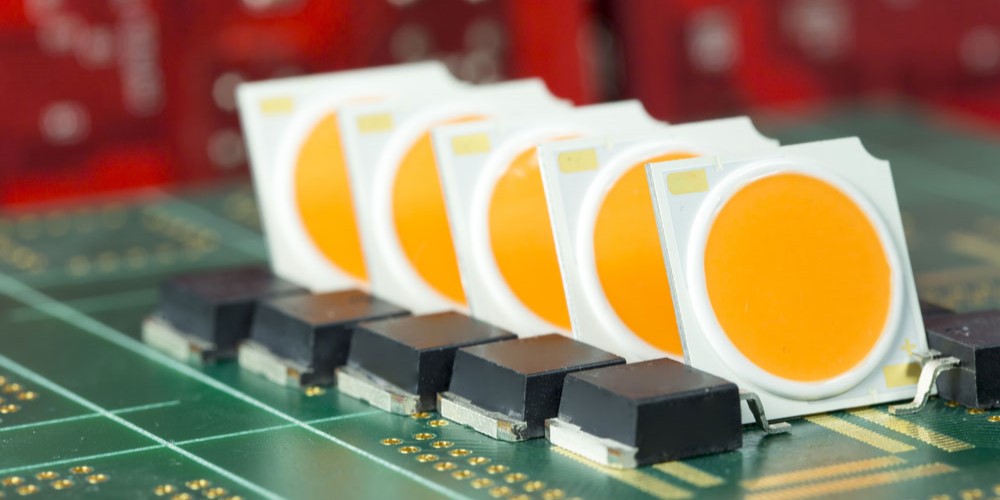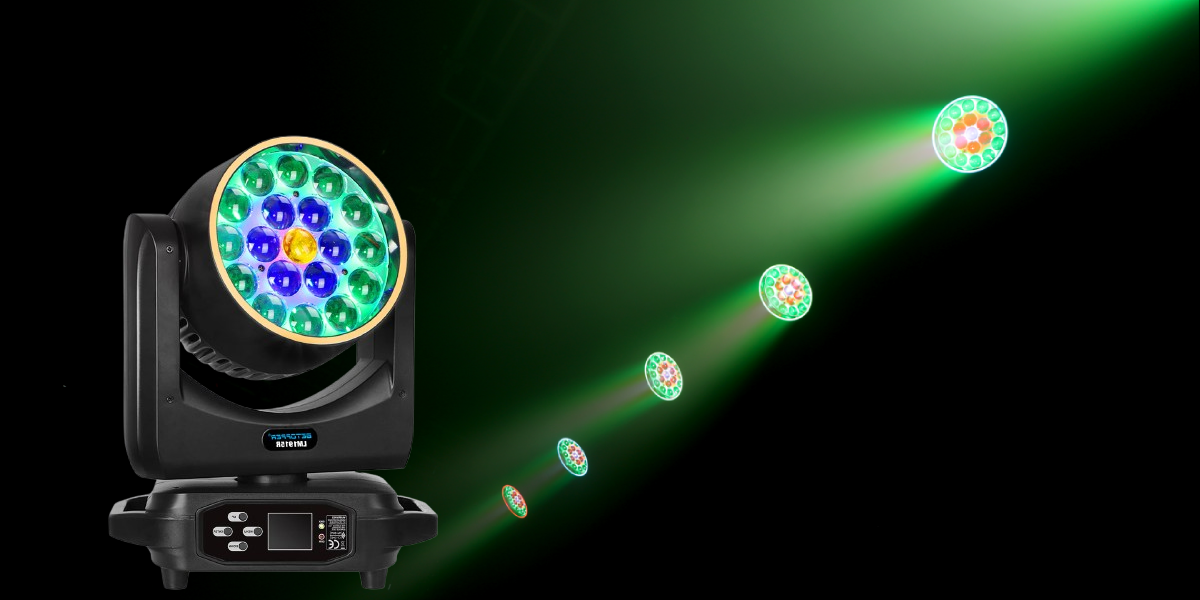COBライトは1ワットあたり80ルーメンという驚異的な明るさを生み出せることをご存知ですか?COBライトは、現在入手可能な最も経済的な照明ソリューションの一つと言えるでしょう。
COBライトは、プロ仕様の照明器具として最も人気があります。 舞台照明写真撮影、作業用照明、屋外設置、商業施設など、様々な用途にご利用いただけます。広いビーム角により、より広い範囲を均一に照らすことができるため、ワークショップや作業現場に最適です。
LED 照明における COB とはどういう意味ですか?
COBは チップオンボード 複数のLEDチップを基板上に直接実装し、単一のモジュールを形成する画期的なLEDパッケージング技術。この技術は、多数の小さな半導体チップを近接して配置する点で従来のLEDとは異なります。これにより、個々のダイオードではなく、一体化した光源のように見えます。
COB LEDのコアコンポーネント
COB LED は、複数の裸の LED チップを熱効率の高い基板 (通常はアルミニウム、セラミック、炭化ケイ素、サファイアなどの材料で作られています) に直接接合することによって構築されます。
これらのチップは、わずか 2 つの電気接点を持つ統合回路を共有し、単一の照明モジュールとして集合的に機能するため、設計が簡素化され、スペース要件が最小限に抑えられます。
この一体型構成により、極めて均一な光出力が得られ、ルーメン密度が大幅に向上します。基板は、機械的な支持を提供するとともに、熱エネルギーを効果的に放散させるヒートシンクとしての役割も担います。
この設計により、高性能 COB LED はワットあたり 150 ルーメンを超える発光効率を実現でき、要求の厳しい照明アプリケーションに最適です。
COB技術の歴史的発展
COB技術の登場は、LED照明の歴史における大きな節目となりました。テキサス・インスツルメンツは、チップ技術におけるこの組立方法を開拓し、大規模生産にいち早く適用した企業の一つです。日本の日亜化学工業は、COB製造に必要な最初のLEDを開発しました。
メーカーは、デュアルインラインパッケージ(浸漬)および表面実装デバイス(表面実装)LED。2016年以降、商用導入が加速しており、多くのメーカーが研究・生産施設に多額の投資を行っています。
COB LED はどのように製造されるのでしょうか?
COB LED の製造には、熱効率と光学的一貫性を確保するように設計された、厳密に制御された一連の手順が含まれます。
このプロセスは、基板(通常は優れた熱伝導性で知られるセラミックPCB)の準備から始まります。LEDチップは、一時的な接着フィルム上に均等に配置され、均一な分布を確保するために、多くの場合、拡張機が使用されます。
ディスペンシングシステムを用いて導電性銀ペーストを基板のボンディングパッドに塗布します。ダイボンダーを用いて、技術者はベアLEDチップをこれらのパッド上に正確に配置します。その後、リフローまたは熱硬化処理を施し、チップと基板間の接続を固めます。
次に、ワイヤボンディング(通常は金またはアルミニウムワイヤ)を用いて電気的相互接続を形成します。一方、高度なCOBモジュールでは、パッド間の直接接続を可能にするフリップチップボンディングを採用する場合もあります。これにより、信頼性と熱性能が向上します。
最後に、アセンブリは LED を保護するための保護材でカプセル化され、その後、厳格な光学的および電気的テストが行われて、パフォーマンスと品質が検証されます。
COB光源の重要な要素
COB LEDは、コンパクトなサイズながら優れた出力を発揮し、優れた技術的性能を備えています。これらの照明ソリューションがプロフェッショナル用途において卓越している理由となる、主要な仕様を見てみましょう。

発光効率
COB LEDは優れた 発光効率 従来の照明技術と比較して、COB照明はコンパクトな構造と効率的な熱管理により、優れた発光効率を実現します。標準的なCOB照明器具は、一般的な用途において、通常80~120ルーメン/ワット(lm/W)の範囲の発光効率を実現します。
高性能モデルは、3000Kの色温度で150 lm/W以上、演色評価数(CRI)80以上を達成し、高品質の照明に適しています。 屋内照明屋外または産業用途向けに最適化された場合、CRI 70 で 6500K で動作する高度な COB 設計は、最大 170 lm/W の効率レベルに到達できます。
注目すべきことに、第6世代COB LEDはこれらの限界をさらに押し広げました。一部のモデルは、85℃の接合部温度で測定された際に184 lm/Wを超える発光効率を示しており、これは室温での実験室テストよりも実際の動作条件をより正確に反映しています。
演色評価数
その 演色評価数(CRI) 光源が自然光と比較して物体の色をどれだけ正確に再現するかを示す重要な指標です。COB LEDは、幅広い用途において安定した高い演色性(CRI)性能を提供するように設計されています。標準的なCOBモジュールは、通常80~90の演色性値を達成しており、色忠実度が重要となるほとんどの商業施設や住宅環境に適しています。
小売店、アートギャラリー、医療現場などの要求の厳しい用途向けに、COB LED は高 CRI バリアント (90+ または 95+) で提供されており、色の精度と視覚的な快適さが向上します。
CRI 値が高くなると発光効率がわずかに低下する可能性がありますが、蛍光体技術と熱制御の進歩により、最新の COB 設計ではこのトレードオフが大幅に最小限に抑えられています。
さらに、COB パッケージは、時間の経過や熱ストレス下でも一貫した CRI パフォーマンスを提供するため、色の安定性が重要な環境に最適です。
電力消費と熱管理システム
COB LEDはワット当たりの光出力が非常に効率的ですが、電気エネルギーの大部分(最大 80%はまだ熱に変換される適切な熱制御を行わないと、接合部温度が 250℃これにより、光束の減衰が加速され、早期のシステム障害が発生するリスクが高まります。
これを軽減するために、メーカーは堅牢な熱管理ソリューションを実装しています。
- パッシブ冷却では通常、熱伝導率が最大 227 W/m·K のアルミニウム ヒートシンクが使用され、標準的なアプリケーションで信頼性の高い放熱を実現します。
- 高出力または密閉型の照明器具の場合、 安全な動作温度を維持し、長期的なパフォーマンスの安定性を確保するために、液体冷却モジュールや合成ジェット技術などのアクティブ冷却システムが導入されています。
| 側面 | パッシブ冷却 | アクティブ冷却 |
|---|---|---|
| 説明 | 自然対流と伝導を利用して熱を放散します。 | 熱除去を強化するために機械的または強制的な方法を採用します。 |
| 材料 | アルミニウムまたは銅製のヒートシンク(200~400 W/m·K)。 | ファン、液体冷却システム、合成ジェット技術。 |
| アプリケーション | 汎用照明、屋外設置、LEDスポットライト。 | 高出力照明器具、密閉環境、産業用照明、舞台照明。 |
| 利点 | 低コスト、メンテナンスフリー、静音、中程度の熱負荷に対する信頼性に優れています。 | 高い熱容量、コンパクトまたは高ワット数のセットアップに適しています。 |
| 制限事項 | 高い熱負荷または限られた空間では効率が制限されます。 | コストが高く、可動部品があり、ノイズが発生する可能性があり、継続的なメンテナンスが必要です。 |
寿命指標
高品質のCOB LEDは50,000~100,000時間持続します。これは、1日8時間使用した場合で17年、24時間365日使用した場合で5~6年の動作寿命を意味します。高度な熱管理と信頼性の高い回路設計により、COB LEDは長期間にわたって安定した性能を維持します。
COB LEDの高度な応用
COBライトは、その独自の技術的利点により、様々な専門分野への導入が急速に進んでいます。強力な出力と均一なビームパターンを実現するCOBライトは、従来の照明では対応できない特殊な用途に最適です。
舞台照明 - PAR、ブラインダーライト
劇場やコンサート会場では COB PARライト 均一な超高輝度ハイブリッドホワイトウォッシュビームを投影し、大規模なスタジアムやパフォーマンススペースに最適です。最新のCOBブラインダーライトは、内蔵の調光プログラムと強力な照明で、 DMXコントローラー 正確な制御を可能にするモード。
舞台照明の専門家は、特に静かなパフォーマンスの際に、この技術が静かに動作することを高く評価しています。多くの照明器具には、58℃以下で無音で動作する温度検知ファンが搭載されています。
Betopper LC500 COB ブラインダーライト
その

主な機能:
✅高出力: LC500 は 4 つの 100W COB LED を搭載し、最大 13,000 ルーメンの強力で均一な光を発するため、大規模な会場やダイナミックなステージ効果に非常に効果的です。
✅高い色精度: CRI 評価は 95 以上で、パフォーマー、衣装、放送環境に不可欠な忠実な色再現を保証します。
✅多用途: 複数の DMX モードとビーム角度の柔軟性を備え、幅広い照明設定に適応できるブラインダー、フラッド、または観客用ライトとして機能します。
👉今すぐチェック:
商業照明
COB LEDは、集光された均一な光出力と精密な光学制御により、商業環境において非常に高い効果を発揮します。コンパクトなマルチダイオードアーキテクチャにより、特に高効率リフレクターと組み合わせることで、狭いビーム角度を実現できます。
このため、COB 照明器具は、ショッピング モール、空港、アトリウムなどの天井の高い空間に最適です。これらの空間では、一般的な SMD システムの拡散光よりも方向性のある照明の方が効果的です。
産業用照明
産業用途において、COB LEDはコンパクトな形状でありながら耐久性と高い光出力を備えています。高出力モデルは通常100Wから500Wの範囲で、発光効率は最大 170 ルーメン/W 最適化されたシステムで。
これらの特性は、運用上の安全性と生産性にとって一貫した照明、長い動作寿命、効率的な熱管理が重要となる倉庫、生産現場、物流拠点などの厳しい環境をサポートします。
スマートホーム照明
COB LEDは、スマートホームのエコシステムへの統合が進み、美観の柔軟性と技術効率の両方を実現します。コンパクトな形状と高いルーメン密度により、照明デザイナーは、インテリジェントな照明制御とシームレスに融合する、洗練されたモダンなプロファイルを作成できます。
調整可能なドライバーと組み合わせることで、COBモジュールは調整可能な色温度をサポートできます(e.gパーソナライズされた周囲設定に不可欠な、明るい色域(2700K~6500K)と調光機能を備えています。
さらに、COB ベースのスマート フィクスチャは Zigbee、Wi-Fi、Bluetooth プロトコルと互換性があり、アプリや音声アシスタントによるリモート制御、スケジュール設定、自動化が可能になります。
彼らの 安定した演色性と長寿命により、リビングルーム、キッチン、ホームオフィスなど、視覚的な快適さとエネルギー効率が両立する必要がある空間に最適です。ホームオートメーションの進化に伴い、COB LEDはコネクテッドリビングの中核的な照明ソリューションとして位置付けられています。
結論
COB LED は、高効率、コンパクトな形状、スマートな適応性により照明デザインを変革し、次世代のセンサー統合型 AI 対応照明ソリューションへの道を開きます。
COBライトに関するよくある質問
1. COB ライトの欠点は何ですか?
COBライトは、ダイオード1個の故障がモジュール全体に影響することが多く、初期費用が高く、修理も困難です。また、グレアが発生する場合があり、低価格モデルでは調光が困難で、安定した性能を得るには安定した電圧が必要になります。
2. COB LED ライトは熱くなりますか?
はい、COB LEDはチップ密度が高いため、かなりの熱を発生し、動作温度は60℃~90℃になることがよくあります。特に高出力や密閉型の設置では、適切なヒートシンクとアクティブ冷却システムが不可欠です。
3. COB LED が黄色いのはなぜですか?
COB LEDは、青色LEDの光を白色光に変換する蛍光体コーティングが施されているため、消灯時には黄色く見えます。このコーティング層は、多くの場合Ce:YAGで作られており、LEDを点灯させた際にバランスの取れた自然な光を確保します。




コメントを残してください
全てのコメントは、掲載前にモデレートされます
このサイトはhCaptchaによって保護されており、hCaptchaプライバシーポリシーおよび利用規約が適用されます。